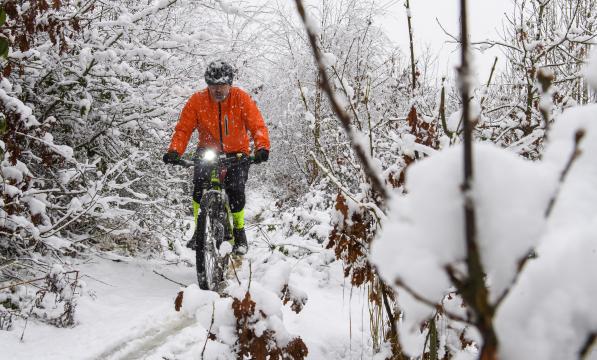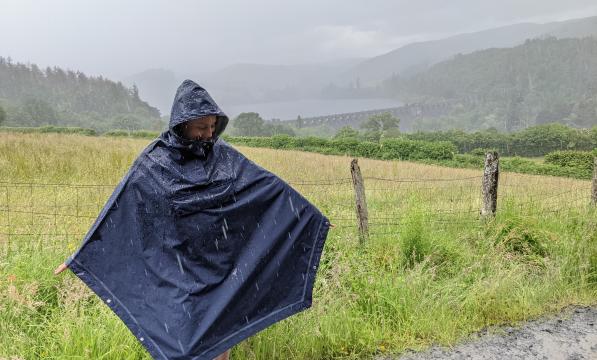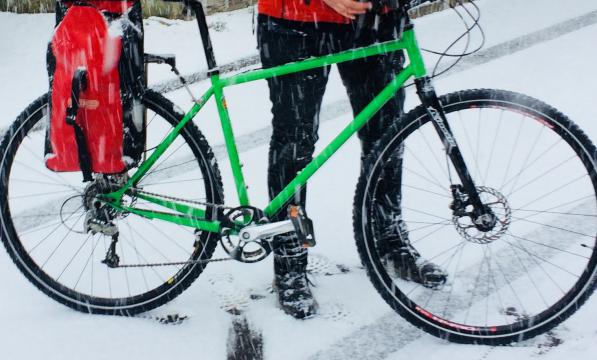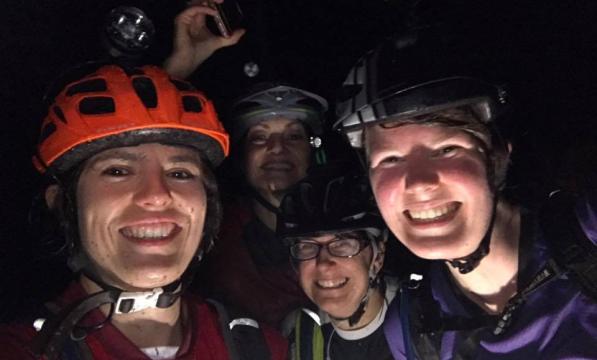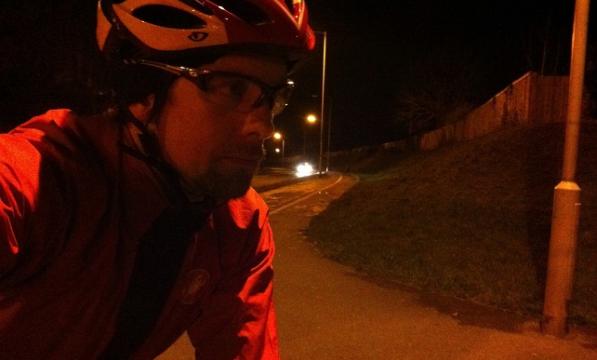How to keep cycling through the winter

A lot of non-cyclists seem to think that “You can’t cycle in bad weather” is the ultimate ‘Gotcha!’ But the fact is that you can ride in almost all conditions – if you’re properly prepared. This comprehensive guide will see you riding throughout winter into spring.
Stay warm and dry
Being cold and wet is miserable even if you’re not on a bike, but keeping warm and dry is even more important if you’re riding – especially if you’re riding to work.
The trick with winter clothing is layering, which you can add or remove to cool down or warm up. How many layers depends on you and when and where you’re cycling. At the least, though, you’ll want a close-fitting, moisture-wicking base layer, an insulating mid-layer, such as a winter cycling jersey, and a water- and wind-proof outer shell.
For your bottom half, winter leggings are a good investment. Look out for ones with water- and wind-proof panels on the front. Ankle zips mean you can fit them over overshoes or winter boots. If it’s really cold, thermal tights under your leggings are a good tip.
Don’t forget your extremities. Thermal gloves and socks, waterproof overshoes, a buff and a thin cap under your helmet, should you wear one, will all help keep you comfortable. Winter booties will be warm and waterproof, but do go up a size on your summer shoes to fit thicker socks. Merino is an excellent material, but can be costly.
Putting your socks, gloves and shoes next to a radiator before setting off means you’ll start with nice warm feet and hands. A spare set of socks and gloves in a drawer at work will save you from having to put on wet ones if you get caught in a downpour on the way to the office.
You don’t need to ride in cycle-specific clothes – plenty of people cycle in civvies every day. The same advice for layering counts, and if it’s raining you might want to avoid jeans, which get very heavy when wet and take a long time to dry.
Investing in a rain cape or poncho will cover you, keeping your clothes dry. These provide great protection on commutes and utility trips, but you’ll probably want to leave it at home for those club rides!
Protecting your eyes is especially important at this time of year: rain, hail and tiny bits of dirt and grit can all do damage. Most cycling glasses come with interchangeable lenses which include a clear one. If you can stretch to photochromatic lenses all the better. That way you’ll protect your eyes from UV rays on those rare sunny days.
See and be seen
This is the mantra of the national standard for cycle training, which the government defines as: “The skills and understanding needed to cycle safely and responsibly, and to enable others to cycle.” This is important all year round, but especially so when daylight hours are limited.
Lights on your bike
Winter riding often means riding in the dark, especially if you’re commuting. This means the most important part of your kit is lights. These will help ensure you can both see and be seen. It’s also a legal requirement to have both a white front and red rear light between dusk and dawn. It’s a good idea to have a spare set handy, too. Our guide to cycle light regulations gives more information.
The exact type of light you need depends on what sort of cycling you do – if you stick to well-lit areas the point is to be seen, if you cycle on unlit roads and tracks the emphasis is on lighting your way. Our handy guide to lights offers more advice.

Rechargeable lights are great if you can charge them at work. But do make sure they’ll stay charged long enough when you’re out. Dynamos can save you money on batteries but cost a lot as you'll most likely need a new front wheel and new front light and rear lights. Most modern dynamo powered lights stay lit for a time after stopping, which is important if you happen to stop at junctions a lot.
Use your clothing to be seen
Hi-vis clothing is a contentious issue, and there’s little research showing that it makes cyclists any safer. At Cycling UK we think it comes down to personal choice. It’s certainly not going to do any harm and if you feel safer then it’s worth the investment.
Research does show, though, that contrasting colours can help make you more visible. It makes sense if you think about it – a cyclist wearing all yellow isn’t going to be visible against a field of blooming rapeseed, regardless of whether it’s hi-vis or not. Conversely, a white or brightly coloured outer shell against a dark background will stand out.
Also backed up by research is the use of retroreflective accessories to make you more conspicuous in the dark. These are made from materials that bounce light back to its source, lighting up in the beam of car headlights, for example.
The theory is that attaching these accessories to limbs makes the most difference as far as detection is concerned because they move, and humans are particularly sensitive to ‘biomotion’ – the movements a biological organism makes. Retroreflective elements on any part of you that moves is likely to aid detection – head, hands, feet and ankles.
Weather-proof your bike
Winter is especially hard on your bike. Rain will wash debris to the roadsides, where you’re likely to be cycling through it. All that water isn’t good for metal parts, either, especially if gritters have been out spreading salt and grit. So you’ll need to give your cycle some extra care and attention.
It’s a good idea to learn some basic maintenance, while a professional bike service will give you peace of mind. These start at around £50. Cycling UK has a wealth of advice on keeping your bike in tip-top condition. In particular, make sure your brakes and gear shifters are working properly.
Are you more likely to get a puncture in winter? Pack a mini-pump and a couple of spare inner tubes just in case …
All that salt and grit also means you’ll have to clean your bike more regularly. No one likes washing their bike, especially on a chilly day, but it really is worth the effort.
Pay particular attention to cleaning and lubricating the drivetrain – chain, chainset, cassette and front and rear derailleurs. Some experts will advise after every ride, but in reality that’s probably not going to happen. Use a wet lube – it’s thicker than dry lube so it lasts longer and is more water repellent.
If your bike hasn’t got them, fit mudguards. This will prevent water and debris from spaying all over fellow cyclists – especially important on group rides – as well as up your back and all over your feet. While you’re there, you might want to look at your tyres. Slicks might be great for speeding along dry summer roads, but you’ll want something grippier and harder wearing in winter. Inflating them a little less improves traction, too.
Are you more likely to get a puncture in winter? Well, there isn’t any research showing this, but it certainly seems to be true anecdotally. Pack a mini-pump and a couple of spare inner tubes just in case or consider going tubeless if your rims are compatible…
Ride to the conditions
Shorter days and the sun being lower in the sky make visibility more difficult. Poor weather also affects how easily you can be seen, as well as making roads more slippery. Plus there’s likely to be extra debris, grit and salt at the sides of roads.
But this doesn’t mean you shouldn’t ride – only that you should adjust your riding style.
Most simply, slow down. This is safer when riding in wet or slippery conditions and gives motorists more time to see you; it also gives your body a bit more time to warm up; a bit of pre-ride stretching will help this too. You’ll also sweat less, which will help keep you warm. Give yourself extra time for your journey to allow for your slower pace.

Stopping distances will be longer in wet or frosty weather; and you should never brake hard in slippery conditions as you’re more likely to lose control.
Take corners slowly and practise controlled braking so you can stop safely when you need to. Keep your brakes covered by putting your fingers over the levers at all times then squeezing both of them together gently and moving your weight more upright to keep the back wheel on the ground.
You might need to ride further out from the kerb than usual – also known as taking the lane or primary position. This will make you more visible to other road users and keep you out of the worst of the debris. Making eye contact with drivers ensures they’ve seen you – this holds true at any time of year.
In the same way that motorists should always look out for more vulnerable road users, cyclists should also watch out for pedestrians, and especially children or pets: they may not always be easy to spot in the dark and can sometimes fail to see or hear you, especially if wearing headphones or talking on mobiles.
Learn to ride according to the time of day and the likely behaviour of other road users; for example, around schools at drop-off and pick-up time or on busy shopping streets.
A good cyclist will continuously risk assess the road or trail and other conditions and adjust their riding accordingly. Be proactive, rather than just ‘hoping for the best’.
Cycling in very snowy or icy conditions, especially on the road, should be only undertaken with extreme caution. If conditions are really bad, there’s no shame in finding an alternative.
Check out our excellent road safety videos for more tips and advice on road positioning. However, there’s no substitute for proper training with a qualified national standard instructor.
Plan ahead
Check the weather forecast before heading out on a long ride. If you can, arrange leisure or group rides for days where reasonable conditions are predicted. Plan what you need to wear and take with you based on the forecast.
Hilly routes, busy main roads, junctions or roundabouts are all potential hazards; consider adjusting your route to avoid them. Use our Journey Planner or other apps such as Komoot (if you're a Cycling UK member, we have a special offer with Komoot) to find an alternative. Keep in mind that traffic-free routes might not be well lit, and use appropriate lights.

Fuel up
You’ll be using extra energy just to maintain body temperature at this time of year, so make sure you’re properly fuelled. Have a decent breakfast or snack before heading out, and take something to eat with you on all but the shortest rides.
It’s important to drink plenty of water. All those layers mean you will sweat and you should always stay hydrated. A warm drink is a great way to heat up from the inside, so if you’ve got an insulated bottle fill it up with your favourite hot drink and take it with you.
The motivator
Riding with others is a great way to stay motivated when the siren call of the sofa is strong. It provides some accountability and makes riding more enjoyable – even in the worst weather.
Cycling UK has groups and clubs throughout the UK, most of which provide group rides all winter. Members can ride with any member group – as well as receiving a range of other benefits including free third-party insurance.
Cycling at any time of year brings many benefits to both mental and physical health. But winter particularly delivers stunning views, and all that fresh air will invigorate you like no other activity can, bringing a glow to your cheeks.
Bear in mind our tips, and you’ll be able to keep riding right through winter, heading into spring feeling fit, happy and healthy. Winter miles mean summer smiles, as they say.

